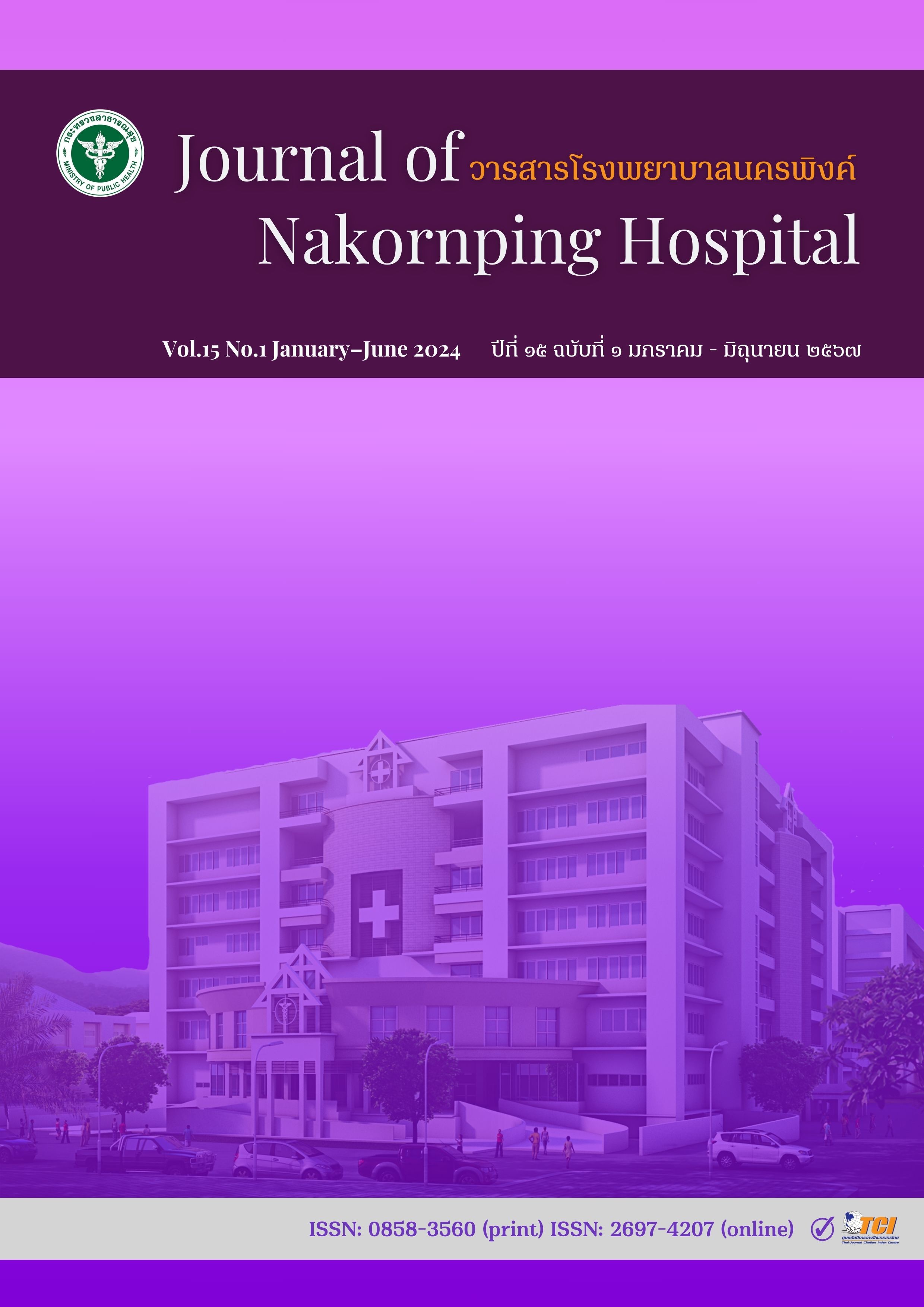ความชุกและปัจจัยที่เกี่ยวข้องกับความร่วมมือในการใช้ยาในผู้ป่วยโรคความดันโลหิตสูงที่คุมไม่ได้ในโรงพยาบาลสันทราย
คำสำคัญ:
ความร่วมมือในการใช้ยา , โรคความดันโลหิตสูง, การแพทย์ปฐมภูมิ , ปัจจัยที่เกี่ยวข้องบทคัดย่อ
ที่มา ในช่วง 20 ปีที่ผ่านมา ผู้ป่วยชาวไทย มีโรคความดันโลหิตสูงเพิ่มขึ้นจากร้อยละ 17 เป็น 24.7 และคุมความดันให้อยู่ในเกณฑ์ได้เพียงร้อยละ 60 เท่านั้น ซึ่งพบว่าหนึ่งในปัจจัยสำคัญเกิดจากขาดความร่วมมือในการใช้ยา แต่การศึกษาในประเทศไทยเกี่ยวกับปัจจัยในการเกิดการขาดความร่วมมือ ในระบบการแพทย์ปฐมภูมิยังมีอย่างจำกัด
วัตถุประสงค์ เพื่อศึกษาหาความชุกและปัจจัยที่สัมพันธ์ต่อการขาดความร่วมมือในการใช้ยาในผู้ป่วยโรคความดันโลหิตสูงที่ยังควบคุมความดันโลหิตไม่ได้ ภายในโรงพยาบาลสันทราย จังหวัดเชียงใหม่
วิธีการศึกษา งานวิจัยแบบภาคตัดขวาง เก็บข้อมูลผู้ป่วยความดันโลหิตสูงอายุ 18 ปีขึ้นไปที่ไม่สามารถควบคุมระดับความดันโลหิตได้ (>140/90 mmHg) ที่เข้ารับบริการในโรงพยาบาลสันทราย ระหว่างเดือนตุลาคม ถึงธันวาคม 2565 โดยเก็บข้อมูลได้แก่ อายุ เพศ โรคประจำตัว การมีผู้ดูแล โดยประเมินความร่วมมือในการใช้ยาด้วยแบบประเมิน Medical adherence scale for Thais (MAST) วิเคราะห์ความชุกและหาความสัมพันธ์ของปัจจัยต่างๆโดยใช้ logistic regression model
ผลการศึกษา ผู้เข้าร่วมวิจัยทั้งหมด 230 ราย พบว่าความชุกของการขาดความร่วมมือในการใช้ยาเท่ากับร้อยละ 35.65 (95% CI: 29.46-42.21) โดยปัจจัยที่มีความสัมพันธ์กับความไม่ร่วมมือในการใช้ยาอย่างมีนัยสำคัญทางสถิติ ได้แก่ กลุ่มที่มีรายได้น้อยกว่า 15,000 บาท (Adj. Odds ratio 3.21, 95% Cl: 1.43-7.18, p-value = 0.005) การมีโรคไตวายเรื้อรังร่วม (Adj. Odds ratio 2.01, 95% Cl: 1.00-4.04, p-value = 0.050) การมีโรค COPD (Adj. Odds ratio3.82, 95% CI: 1.32-11.00, p-value =0.013)
สรุป ผู้ป่วยโรคความดันโลหิตสูงที่ควบคุมความดันโลหิตได้ไม่ดีในระบบการแพทย์ปฐมภูมิมีความเกี่ยวพันธ์กับความไม่ร่วมมือในการใช้ยา มีมากถึง1 ใน 3 จึงควรพัฒนาแนวทางการจัดการรวมถึงมาตรการเชิงรุกเพิ่มเติมและเฉพาะกลุ่มต่อไปในอนาคต
References
Srivanichakorn S. Morbidity and mortality situation of non-communicable diseases (diabetes type 2 and cardiovascular diseases) in Thailand during 2010-2014. Disease Control Journal. 2017;43(4):379-90. [In Thai]
United Nations Thailand, Ministry of Public Health (Thailand), UN Interagency Task Force on NCDs. Prevention and Control of Noncommunicable Diseases in Thailand – The Case for Investment. Bangkok: United Nations Thailand; 2021. Available from: https://www.sdgport-th.org/2021/11/prevention-and-control-of-noncommunicable-diseases-in-thailand-the-case-for-investment/
De Geest S, Ruppar T, Berben L, Schönfeld S, Hill MN. Medication non-adherence as a critical factor in the management of presumed resistant hypertension: a narrative review. EuroIntervention. 2014;9(9):1102-9. doi: 10.4244/EIJV9I9A185.
Aekplakorn W, Abbott-Klafter J, Khonputsa P, Tatsanavivat P, Chongsuvivatwong V, Chariyalertsak S, et al. Prevalence and management of prehypertension and hypertension by geographic regions of Thailand: the Third National Health Examination Survey, 2004. J Hypertens. 2008;26(2):191-8. doi: 10.1097/HJH.0b013e3282f09f57.
Gutierrez MM, Sakulbumrungsil R. Factors associated with medication adherence of hypertensive patients in the Philippines: a systematic review. Clin Hypertens. 2021;27(1):19. doi: 10.1186/s40885-021-00176-0.
Lo SH, Chau JP, Woo J, Thompson DR, Choi KC. Adherence to Antihypertensive Medication in Older Adults With Hypertension. J Cardiovasc Nurs. 2016;31(4):296-303. doi: 10.1097/JCN.0000000000000251.
Rahmawati R, Bajorek B. Factors affecting self-reported medication adherence and hypertension knowledge: A cross-sectional study in rural villages, Yogyakarta Province, Indonesia. Chronic Illn. 2018;14(3):212-27. doi: 10.1177/1742395317739092.
Thirunavukkarasu A, Naser Abdullah Alshahrani A, Mazen Abdel-Salam D, Homoud Al-Hazmi A, Farhan AB, Awad Alsaidan A, et al. Medication Adherence Among Hypertensive Patients Attending Different Primary Health Centers in Abha, Saudi Arabia: A Cross-Sectional Study. Patient Prefer Adherence. 2022;16:2835-44. doi: 10.2147/PPA.S388365
Woodham N, Taneepanichskul S, Somrongthong R, Auamkul N. Medication adherence and associated factors among elderly hypertension patients with uncontrolled blood pressure in rural area, Northeast Thailand. Journal of Health Research. 2018;32(6):449-58. doi: 10.1108/JHR-11-2018-085
Ezeala-Adikaibe BA, Mbadiwe N, Okudo G, Nwosu N, Nwobodo N, Onyebueke G, et al. Factors Associated with Medication Adherence among hypertensive Patients in a Tertiary Health Center: A Cross-Sectional Study. Arch Community Med Public Health. 2017;3(1):024-31. doi: http://dx.doi.org/10.17352/2455-5479.000021
Sathapornnanon N. Medication non adherence. Thai Journal of Pharmacy. 2012;7(1):23-39. doi: https://doi.org/10.14456/tbps.2012.2 [In Thai]
National High Blood Pressure Education Program. The Seventh Report of the Joint National Committee on Prevention, Detection, Evaluation, and Treatment of High Blood Pressure. Bethesda (MD): National Heart, Lung, and Blood Institute (US); 2004. Available from: https://www.ncbi.nlm.nih.gov/books/NBK9630/
Williams B, Mancia G, Spiering W, Agabiti Rosei E, Azizi M, Burnier M, et al. 2018 ESC/ESH Guidelines for the management of arterial hypertension. Eur Heart J. 2018;39(33):3021-3104. doi:10.1093/eurheartj/ehy339.
Jongwilaikasem K, Lerkiatbundit S. Development of the Medication Adherence Scale for Thais (MAST). Thai Journal of Pharmacy Practice. 2021;13(1):17-30. [In Thai]
Schneider J, Kaplan SH, Greenfield S, Li W, Wilson IB. Better physician-patient relationships are associated with higher reported adherence to antiretroviral therapy in patients with HIV infection. J Gen Intern Med. 2004;19(11):1096-103. doi: 10.1111/j.1525-1497.2004.30418.x.
Ramli A, Ahmad NS, Paraidathathu T. Medication adherence among hypertensive patients of primary health clinics in Malaysia. Patient Prefer Adherence. 2012;6:613-22. doi: 10.2147/PPA.S34704.
Burnier M. Drug adherence in hypertension. Pharmacol Res. 2017;125(Pt B):142-49. doi: 10.1016/j.phrs.2017.08.015.
Hometowska H, Swiatoniowska-Lonc N, Klekowski J, Chabowski M, Jankowska-Polanska B. Treatment Adherence in Patients with Obstructive Pulmonary Diseases. Int J Environ Res Public Health. 2022;19(18):11573. doi: 10.3390/ijerph191811573.
Downloads
เผยแพร่แล้ว
How to Cite
ฉบับ
บท
License
Copyright (c) 2024 โรงพยาบาลนครพิงค์

This work is licensed under a Creative Commons Attribution-NonCommercial-NoDerivatives 4.0 International License.
บทความที่ได้รับการตีพิมพ์เป็นลิขสิทธิ์ของโรงพยาบาลนครพิงค์ จ.เชียงใหม่
ข้อความที่ปรากฏในบทความแต่ละเรื่องบทความในวารสารวิชาการและวิจัยเล่มนี้เป็นความคิดเห็นส่วนตัวของผู้เขียนแต่ละท่านไม่เกี่ยวข้องกับโรงพยาบาลนครพิงค์ และบุคลากรท่านอื่นๆในโรงพยาบาลฯ ความรับผิดชอบเกี่ยวกับบทความแต่ละเรื่องผู้เขียนจะรับผิดชอบของตนเองแต่ละท่าน



